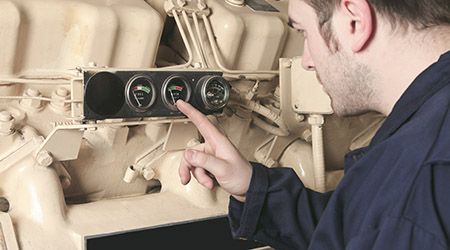The Los Angeles County Emergency Medical Services (EMS) Agency is addressing an aging hospital generator fleet by deploying technology that will provide automated, real-time alerts anytime a hospital generator experiences a mechanical problem during a power outage.
The Power Information Needed to Expedite Emergency Response (P.I.O.N.E.E.R.) tool was installed at two of Los Angeles County’s single-generator, acute care hospitals. The tool continuously monitors generator performance and sends automated, real-time warnings to designated individuals anytime a generator experiences a mechanical problem during a power outage.
Power P.I.O.N.E.E.R. was developed by the 501c3 non-profit Powered for Patients as part of a U.S. Department of Homeland Security-funded initiative to spur advances in generator monitoring technology that would provide an early warning to government officials and utilities when critical facilities face a threat to emergency power during an outage. Power P.I.O.N.E.E.R. is also designed to provide ongoing, real-time updates on the status of efforts by government officials, utilities and service providers to respond to a stricken facility.
The deployments represent the first time a U.S. hospital is making automated, real-time generator threat alerts available to government emergency managers. The early warnings will give utilities the opportunity to quickly assess options for prioritized power restoration including switching feeder lines to a hospital in cases where two lines exist and one of them is still able to provide power to the hospital.
Deployment of Power P.I.O.N.E.E.R. to single generator hospitals was essential since these facilities have no redundant emergency power, and as a result, put patients at greater risk if the facilities experience a total loss of emergency power. The Los Angeles County EMS Agency is tapping its HHS Hospital Preparedness Program funding to cover the cost of deploying the Power P.I.O.N.E.E.R. tool in the county’s single generator hospitals.
Among LA county’s 14 single-generator acute care hospitals, nine of these facilities, or 64 percent, have generators more than 30 years old, including three with generators between 40 and 49 years of age, three with generators between 50 and 59 years of age and one with a generator more than 60 years old. There are no federal or state requirements that limit the age of a hospital generator as long as the generator can pass periodic tests.
"Given the ongoing threat of Public Safety Power Shutoffs, and the potential for other types of power outages in Los Angeles County, we’re excited to see Power P.I.O.N.E.E.R. providing real time situational awareness of generator threats at the county’s single generator hospitals,” says Eric Cote, project director for Powered for Patients. “This visibility is especially important since single-generator hospitals have no redundant emergency power and in some cases are relying on older generators. As more of LA County’s single-generator hospitals deploy Power P.I.O.N.E.E.R., the impact of this powerful new tool in protecting patients will become even greater.”
Concern about outdated hospital generators in Los Angeles County is driven by a recently completed analysis documenting a seriously aging fleet. The analysis of the generator fleet in Los Angeles County’s hospitals is part of the Los Angeles County EMS Agency’s ongoing emergency power preparedness initiative being led by Powered for Patients. The analysis reflects survey data from the county’s 80 hospitals that participate in the Hospital Preparedness Program which have a combined total of 271 generators. The useful life expectancy of a generator is approximately 30 years of age and the recent analysis showed that 87 out of the 271 generators, or 32 percent, are older than 30 years of age, with 40 of these generators between 40 and 49 years of age and 15 of the generators older than 50 years of age.

 UF Health Hospitals Rely on Green Globes to Realize Their Full Potential
UF Health Hospitals Rely on Green Globes to Realize Their Full Potential How Healthcare Facilities Can Be Truly Disaster-Resilient
How Healthcare Facilities Can Be Truly Disaster-Resilient TriasMD Breaks Ground on DISC Surgery Center for San Fernando Valley
TriasMD Breaks Ground on DISC Surgery Center for San Fernando Valley Bigfork Valley Hospital Falls Victim to Data Breach
Bigfork Valley Hospital Falls Victim to Data Breach AI-Driven Facilities: Strategic Planning and Cost Management
AI-Driven Facilities: Strategic Planning and Cost Management